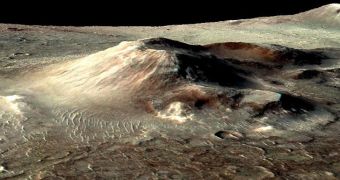New studies of the Martian surface have demonstrated that small habitats that could have been capable of supporting life may have existed on the Red Planet some three billion years ago.
This conclusion comes from analyzing datasets beamed back by a NASA orbiter, which revealed the existence of mounds of light-colored minerals on a volcanic cone. The geological structure is very old.
Investigators at the Jet Propulsion Laboratory (JPL) say that the material was nothing else than hydrated silica. They also used the Mars Reconnaissance Orbiter (MRO) to determine how was it that the material got on the volcano.
When the team analyzed the location and composition of the silica mounds, the scientists realized that they could very well be looking at the first intact remnants of an ancient hydrothermal vent.
It could be that the formation once was a Steam fumarole, or maybe even a hot spring, of the type that can be found near volcanoes, or on the bottom of the oceans, here on Earth.
The kicker is that hydrothermal vents on our planet may have been the homes of the earliest life forms that appeared here, and then went on to develop into more complex creatures, such as ourselves.
“The heat and water required to create this deposit probably made this a habitable zone. If life did exist there, this would be a promising type of deposit to entomb evidence of it – a microbial mortuary,” says expert J.R. Skok.
The scientist, who is based at the Brown University, in Providence, is the lead author of a new paper detailing the study, which appears in the October 31 online issue of the top journal Nature Geoscience.
The new work is important because it adds to a growing volume of evidence suggesting that, in Mars' ancient history, the planet may have had habitable environments, at least at a local scale.
While no studies have ever conclusively demonstrated that our neighboring planet supported life, researchers are confident that some areas may contain microbes and other traces of early life forms.
What is interesting to note about this particular study, and the grounds it covers, is that life may have existed here after the planet turned dry and cold, billions of years ago.
“You have spectacular context for this deposit. It's right on the flank of a volcano. The setting remains essentially the same as it was when the silica was deposited,” Skok goes on to explain.
“We can read a series of chapters in this history book and know that the cone grew from the last gasp of a giant volcanic system,” says Skok's thesis advisor, John Mustard, also a coauthor of the research paper.
“The cooling and solidification of most of the magma concentrated is silica and water content,” he concludes.

 14 DAY TRIAL //
14 DAY TRIAL //